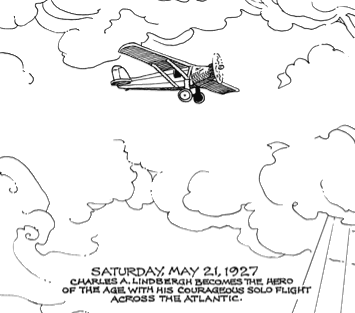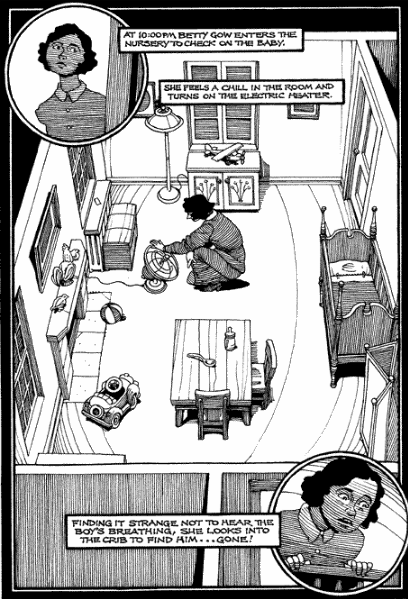A Revamp for Which Little Changes
A Treasury of XXth Century Murder: The Lindbergh Child

They stopped numbering them a while ago, but this is actually the 10th of NBM's collections of comics reportage from Rick Geary, a prolific cartoonist and illustrator (National Lampoon, Heavy Metal) who's been creating short and long works about murder for over 20 years. One of the earliest Fantagraphics catalogs I can recall flipping through (back when they listed a lot of books they didn't publish) had Vol. 2 of the series -- Jack the Ripper -- listed beside the brick of intimidation that was the newly-collected From Hell. Geary's book was recommended as a good alternative viewpoint; certain at the time that bigger and more visible could only possibly mean better, I wondered how such a short, small book could stack up.
Longtime readers will notice something different about this particular short, small book, an 80-page hardcover, priced at $15.95 - what was once a Treasury of Victorian Murder has now advanced into a more recently expired century. But the change in temporal venue appears to be the only major shift in Geary's work, and I think that's good, since there's not a lot of comics around like this anymore, here in 2008.
Granted, I'm not sure if concise, focused, research-heavy histories-as-comics were ever quite overwhelming in number, but Geary's wordy, illustrative approach -- a cool, just-the-facts narration running over plenty of headshots, frozen scenes and the occasional map or chart -- seems planted in an earlier era of nonfiction alternative comics, one eager to disseminate information as less a sleekly visual story than an especially intuitive essay. I suspect you can draw a fairly straight line backwards from this sort of comic, all the way through the nonfiction of the underground, ending at the influential heavy narratives of Al Feldstein and Bill Gaines at EC.

That's not to say that Geary's work clanks around, or is somehow visually deficient. It's actually very artful, given its narrative scheme, with bookending images of an airplane soaring through doodled-line clouds opening and closing the work, as if to build up Geary's art into solidification as he clears his throat, then to let it go once there's nothing left to say. They're similar images that carry different emotional charges from Geary's words - the first one showcases the might of famed aviator Charles Lindbergh's challenge of the sky and sea, a small jut of human effort piercing the vastness of its environment, while the last depicts the man's flight to spread the ashes of his mudered son over the Atlantic, his trajectory more an expression of impossible emotional isolation in the midst of the acts that built his fame.
The Lindbergh kidnapping/murder of 1932 was a very famous event concerning a very famous man - Geary could scarcely have picked a richer killing with which to start his 20th century, and he makes sure to drop in little details regarding the media frenzy that grew to accommodate public fascination with Charles Jr.'s short life even prior to his vanishing, so as to better connect such publicity practice to the present day. The artist also knows well that he's working on a settled but not uncontroversial case, and even his cover art reflects it - note that we see nothing of the kidnapper's face or gender, and that any accomplices are kept away from our eyes. Geary is used to uncertainty; really, his storytelling thrives on it, as it offers so many new strains of odd, bleak history to convey.

So Geary moves us through the general chronology, darting down side streets and pausing to duck into the past of notable figures. Someone is put to death by the state, but little is really resolved, as you might come to expect from witnessing the artist's digressions into continuing lives. Considering the density of information involved, this is a fast-reading book, and I expect that's wholly due to Geary's skill with intermingling precisely as much narration as needed at one time with descriptive/mordant/funny images, special emphasis placed on the faces of oddballs, conmen and miscellaneous uneasy folks called to play a cameo role in Big Public History.
It's not an easy type of comic to make, even among research-heavy projects. There's a great risk with this type of work in slowing the reader down past the point of boredom, or forcing the dreaded question of why this is a comic anyway. I suppose that can be answered on its face -- you can probably make the argument that comics is better equipped to act as a historical survey if only for the ease of comprehension that images teamed with words can provide -- but here there's no question that Geary's work must take this form, his careful command leading the reader easily down the winding path his narrative interests demand.
I'm not saying much here that isn't applicable to Geary's earlier books in this (extended) series, I know - that's because only the name and the murder has really changed. It's fitting that Geary's other current comics project is the ongoing Gumby series with writer Bob Burden; the latter is another artist whose vision remains very constant through years of progress, his particulars evolving and shifting as artists' works always do, yes, but his general aesthetic seeming to defy time. Geary's murders are likewise still, and, through their effective execution, become more fascinating from the pause.

They stopped numbering them a while ago, but this is actually the 10th of NBM's collections of comics reportage from Rick Geary, a prolific cartoonist and illustrator (National Lampoon, Heavy Metal) who's been creating short and long works about murder for over 20 years. One of the earliest Fantagraphics catalogs I can recall flipping through (back when they listed a lot of books they didn't publish) had Vol. 2 of the series -- Jack the Ripper -- listed beside the brick of intimidation that was the newly-collected From Hell. Geary's book was recommended as a good alternative viewpoint; certain at the time that bigger and more visible could only possibly mean better, I wondered how such a short, small book could stack up.
Longtime readers will notice something different about this particular short, small book, an 80-page hardcover, priced at $15.95 - what was once a Treasury of Victorian Murder has now advanced into a more recently expired century. But the change in temporal venue appears to be the only major shift in Geary's work, and I think that's good, since there's not a lot of comics around like this anymore, here in 2008.
Granted, I'm not sure if concise, focused, research-heavy histories-as-comics were ever quite overwhelming in number, but Geary's wordy, illustrative approach -- a cool, just-the-facts narration running over plenty of headshots, frozen scenes and the occasional map or chart -- seems planted in an earlier era of nonfiction alternative comics, one eager to disseminate information as less a sleekly visual story than an especially intuitive essay. I suspect you can draw a fairly straight line backwards from this sort of comic, all the way through the nonfiction of the underground, ending at the influential heavy narratives of Al Feldstein and Bill Gaines at EC.

That's not to say that Geary's work clanks around, or is somehow visually deficient. It's actually very artful, given its narrative scheme, with bookending images of an airplane soaring through doodled-line clouds opening and closing the work, as if to build up Geary's art into solidification as he clears his throat, then to let it go once there's nothing left to say. They're similar images that carry different emotional charges from Geary's words - the first one showcases the might of famed aviator Charles Lindbergh's challenge of the sky and sea, a small jut of human effort piercing the vastness of its environment, while the last depicts the man's flight to spread the ashes of his mudered son over the Atlantic, his trajectory more an expression of impossible emotional isolation in the midst of the acts that built his fame.
The Lindbergh kidnapping/murder of 1932 was a very famous event concerning a very famous man - Geary could scarcely have picked a richer killing with which to start his 20th century, and he makes sure to drop in little details regarding the media frenzy that grew to accommodate public fascination with Charles Jr.'s short life even prior to his vanishing, so as to better connect such publicity practice to the present day. The artist also knows well that he's working on a settled but not uncontroversial case, and even his cover art reflects it - note that we see nothing of the kidnapper's face or gender, and that any accomplices are kept away from our eyes. Geary is used to uncertainty; really, his storytelling thrives on it, as it offers so many new strains of odd, bleak history to convey.

So Geary moves us through the general chronology, darting down side streets and pausing to duck into the past of notable figures. Someone is put to death by the state, but little is really resolved, as you might come to expect from witnessing the artist's digressions into continuing lives. Considering the density of information involved, this is a fast-reading book, and I expect that's wholly due to Geary's skill with intermingling precisely as much narration as needed at one time with descriptive/mordant/funny images, special emphasis placed on the faces of oddballs, conmen and miscellaneous uneasy folks called to play a cameo role in Big Public History.
It's not an easy type of comic to make, even among research-heavy projects. There's a great risk with this type of work in slowing the reader down past the point of boredom, or forcing the dreaded question of why this is a comic anyway. I suppose that can be answered on its face -- you can probably make the argument that comics is better equipped to act as a historical survey if only for the ease of comprehension that images teamed with words can provide -- but here there's no question that Geary's work must take this form, his careful command leading the reader easily down the winding path his narrative interests demand.
I'm not saying much here that isn't applicable to Geary's earlier books in this (extended) series, I know - that's because only the name and the murder has really changed. It's fitting that Geary's other current comics project is the ongoing Gumby series with writer Bob Burden; the latter is another artist whose vision remains very constant through years of progress, his particulars evolving and shifting as artists' works always do, yes, but his general aesthetic seeming to defy time. Geary's murders are likewise still, and, through their effective execution, become more fascinating from the pause.

<< Home